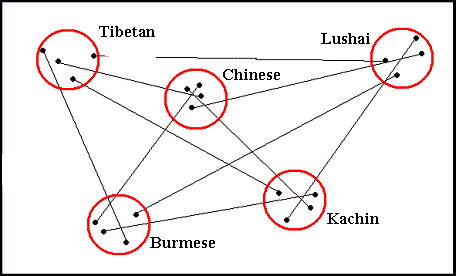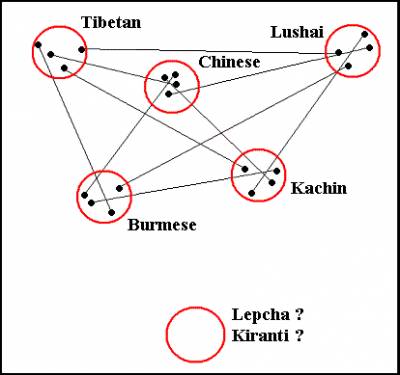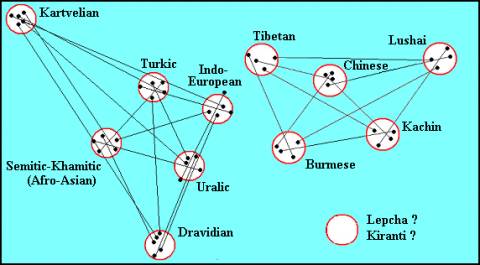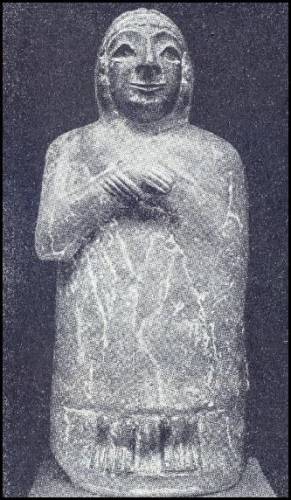The Relationship of the Sino-Tibetan Languages
The Sino-Tibetan family consists of about 300 languages, which immediately casts doubt on the possibility of studying them by the graphical-analytical method, without pre-classification them by methods purely linguistic. This problem is still not fully resolved, but seven of these languages were singled out in the project "Tower of Babel"and their etymology was presented in tabular form. Such a representation of relationships allowed for a graphics system of kinship. In total, the database included 2,775 of the roots for the following languages: Chinese, Tibetan, Burmese, Kachin, Lushai, Lepcha, and Kiranti. And 91 roots can be considered as common to all these languages, and 174 occurs in only one of them. All they were excluded from the list that was used for counting the number of common words in pairs of languages. These data are shown in the table.
Table 1. The amount of common words between the Sino-Tibetan languages
| Language |
Chinese |
Tibetan |
Kachin |
Burmese |
Lushai |
Kiranti |
Lepcha |
| Chinese |
1704 |
|
|
|
|
|
|
| Tibetan |
920 |
1393 |
|
|
|
|
|
| Kachin |
716 |
548 |
1262 |
|
|
|
|
| Burmese |
736 |
621 |
595 |
1254 |
|
|
|
| Lushai |
546 |
445 |
440 |
240 |
1036 |
|
|
| Kiranti |
296 |
270 |
234 |
242 |
231 |
454 |
|
| Lepcha |
264 |
253 |
222 |
106 |
209 |
94 |
425 |
The total amount of words of each language taken for analysis is shown in the diagonal of the table. Immediately evident that it is disproportionately small for languages Kiranti and Lepcha compared with other languages. Reasons for this may be different. Perhaps these languages are not sufficiently understood, but may be the ancestors of speakers lived far enough away from the rest of the Sino-Tibetan. There are other possible causes, but one way or another, the two languages do not fit into the graphical model of kinship Sino-Tibetan languages, although, of course, they are genetically closely related to them. A graphical representation of the Sino-Tibetan languages is filed in the diagram on the right. This, rather than a mirror version of the model was chosen because it meets the modern places of settlement of Tibetans, Chinese and Burmese. The graphic model of the relationship of the Sino-Tibetan languages is shown below.

As you can see, the points for each of the languages are fairly compact what testifies to the correctness of the lexical material and about the adequacy of the representation of the kinship system. It was assumed that the Sino-Tibetan Urheimat was somewhere in Central Asia or the Far East. However, the search here on the map for a place, which might suit this scheme, failed. Apparently, there is no such place in this part of Asia at all.
Since the configuration of the model resembles the chart of kinship Nostratic languages, they can be similar, if an area of any of the languages (Lepcha or Kiranti) was below (south) the areas of the Burmese and Kachin Languages. We have grounds for such assumption because preceding studies have shown that the location of the areas of settlement of related peoples corresponds to a certain extent to the location of their Urheimats at the time of formation of their languages.

Currently, speakers of the languages Lepcha and Kiranti live closer to the Burmese than to the Chinese. The Lepcha folk is the indigenous people of the State of Sikkim in India, which is located between Nepal and Bhutan. The Kiranti people living in Nepal. All this is not far from Burma, but also from Tibet, too. The proposed scheme of kinship Sino-Tibetan languages is shown above. The similarity of diagrams of the Sino-Tibetan kinship with Nostratic languages is striking (see the diagram right).

The comparison of the kinship models of the Sino-Tibetan and Nostratic languages
Accordingly, we have reason to locate the Urheimat of the Sino-Tibetans in the area of three lakes Van, Sevan, and Urmia (Rezaye) in Asia Minor (see map below).
Thus, the Tibetan language was formed on the Plateau of Kars in the upper valleys of the rivers Kura and Chorokh. Chinese was in the valley of the Aras at Lake Sevan. The Urheimat of the folk Lepcha was located further downstream the Aras. Burmese was formed near the Lake Van, and Kachin was near the Lake Urmia (Rezaye). The area in the valley of the Great Zab likely was inhabited not by folks Lepcha or Kiranti, which location of settlements could be somewhere in the eastern part of Asia Minor, having in mind their present place of settlements and their distant relationship with other Sino-Tibetan languages.
The idea about the Urheimat of the Sino-Tibetan people in Western Asia is not new. French scholar Terrien de la Couperie (1845-1894), theauthor of the book " The Early History of Chinese Civilization" had found the distinct resemblance between the Chinese and the early Akkadian hieroglyphics. In addition he demonstrated lexical correspondences between the Chinese language and Babylonian dialect of Akkadian which was used by people in Chaldea. Other affinity found by him let to say about the correspondence between the civilization of the Chinese and those of Elam and Chaldea. These discoveries lay in the basis of his theory about an Elamite origin of the Chinese forefathers. He found many place names which could trace en route of some tribes have come from Western Asia to the Yellow River Valley. C. J. Ball developed and supplemented the research of Terrien de la Couperie and tried to convince the learned world about western origin of the Chinese system of writing and about the connection between the Chinese and the ancient Accadian languages. Thus, several theories arised later which pointed Chinese Urheimat to Babylonia or even to Egypt. However other scholars, for example, Herbert A. Giles considered Couperie's theory as a nonsense (Aylmer Charles, The Memoirs of H. A. Giles, East Asian History 13–14, 1997: 25) and E. H. Parker saw nothing to be connected with Chinese and Akkadian or Egyptian forms of writing (Williams E.T., The origins of the Chinese: American Journal of Rhisical Anthropology.1918, 208).
E. T. Williams considered in detail the theory of Chinese Urheimat in Central or Western Asia beside two others in his article "The origins of the Chinese" published in "American Journal of Anthropology" in 1918. He noted that it was difficult separate the facts given by Terrien de la Couperie and his guesses but he was certain that de Lacouperie's theory "enables us to give a very satisfactory explanation of the striking similarity between the language of ancient China and that of the Sumerians and the still more striking similarity between the ideographic symbols of the two peoples" (Williams E.T., The origins of the Chinese: American Journal of Rhisical Anthropology.1918, 207).
Anthropological differences seem to contradict the idea of any connection between Chinese and Babylonians but L. W. King noted obliquely-set eyes of figures in early Sumerian reliefs.
Left: Statue of a notable Sumer. Lagash. Circa 2500 BC.
The statue of a notable Sumer from circa 2500 BC sows really just a little obliquely-set eyes of the man. This could be sign of the cross-breading Caucasoids with Mongoloids. What this sign is expressed rather weakly could be explained by that Mongoloids left Sumer some millenniums before.
It is certain that Sumerians were not Semites and E. T. Williams accoprding with other scholars thought that they had some Turanian features therefore come to such conclusion:
We have, then, the facts that various Chinese tribes appear to have come in to what is now China from some region to the northwest of that country, and that the Sumerians appear to have come into the Euphrates Valley from some place to the northeast of Babylonia; that the Sumerians were apparently of the Turanian race, and that their language and their script are strikingly like those of the ancient Chinese; and that extensive changes in the climate of Central Asia have driven out at different periods great numbers of the inhabitants who have migrated in various directions. It does not seem at all improbable then that the Chinese forefathers and the ancestors of the Sumerians may have been related and may have migrated from neighboring regions, the Chinese toward the east and the Sumerians toward the west (Williams E.T., The origins of the Chinese: American Journal of Rhisical Anthropology.1918, 211).
At our time scholar comparing Chinese and Sumerian writing systems turn attention more to their difference as similarity and the theory about West Asian origin of Chinese almost has no adherents. Obviously common attitude to this probem was expressed by John DeFransic, an American sinologist:
… it seems to me that while some of the principles underlying Chinese writing are in fact similar to those underlying Sumerian writing, in all probability the reason for this is not that one was influenced by the other. The distances in time and space, unlike the Sumerian-Egyptian and Phoenician-Greek situations.., militate against such a hypothesis. A more reasonable explanation is that the two peoples independently thought up somewhat similar solutions to somewhat similar problems (JOHN DEFRANCIS. 1989. Visible Speech: The Diverse Oneness of Writing Systems. http://cdli.ucla.edu/staff/englund/m20/defancis1989_oneness_chinese.pdf)
However these distances could be shorter if remains of Chinese ancestors stayed on their Urheimat in West Asia after majority of them migrated eastward. The time of the stay of Sino-Tibetan people in Urheimat should be attributed to the Upper Palaeolithic, because later this place was dwelt by the carriers of the Nostratic languages, which came here from the west, droving the original inhabitants eastward and assimilating or killing their remains. The Sino-Tibetans moved to Central Asia, where they became the creators of the local Mesolithic cultures. They arrived to current places of habitat as early as the Neolithic or it was brought with them, since neither in China nor Burma reliable traces of Mesolithic period were not found.

Right:
Statue of a bearded priest from Mohenjo-daro.
Obviously, people of the Mongoloid race are leaving in Central Asia before the arrival of Dravidians. Availability Mongoloid traits in priest from Mohenjo-daro can confirm this assumption.
It is clear that the Sino-Tibetans belong to the yellow race, to which also belonged the Indians of America, the peoples of the Mongolian and Manchu-Tungus groups. Since the languages of these latter do not contain clear signs of kinship with the Sino-Tibetan, ie they were formed very far from the settlement of the Sino-Tibetans, we have to assume that people of yellow race inhabited a vast area in Asia at time when human language was held only the initial phase of its formation.
We adhere to the hypothesis of monocentrism, according to which type of modern man emerged in the Near East and the Mediterranean as a result of mixing of different representatives of the Neanderthal type. Typological heterogeneity of people of different races in the Upper Paleolithic was smaller than it is now. (SHCHOKIN HEORHIY, 2002: 77). In other words, the difference between the prototypes of the people of Caucasoid and Mongoloid races were insignificant and they were living in the same environmental conditions of Southwest Asia. After Mongoloids migrated along the broad expanse of Asia, their original phenotypic traits have been developed in different ways under the influence of natural conditions of different habitats. As a result of their difference from the people of the white race has increased, but at the same time two distinct racial types were developed, which gave rise to a modern Mongoloids and Amerikanoids.


















